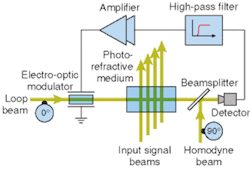Dynamic holographic system pulls signal from noise
Researchers at the University of Colorado (Boulder, CO) have demonstrated that optical parallelism can be used to outperform conventional (serial) computers for information processing. Dana Anderson and his team have built a system that can perform independent component analysis (ICA), a method for extracting a single information channel from several that have been superimposed (like filtering out all but a lone voice at a cocktail party). Crucially, it can do this in real time, and at bandwidths that would be impractical for electronic systems. Further, they can extend this to separating all components of a mixed signal by adding optical-signal-filtering techniques (already developed within the same group) to the mix. The research is aimed at providing high-bandwidth, real-time processing of radio-frequency and microwave signals for reconnaissance eavesdropping.
There are two keys to the success of independent component analysis: the statistical nature of the signals to be processed and their independence from each other. Essentially, the amplitude of each time-varying signal can be thought of as a random variable with a distribution. The first thing that would make them impossible to split would be if they had Gaussian distributions: one Gaussian on top of another Gaussian just looks like a Gaussian. Not surprisingly, if the signals are somehow dependent on each other (that is, if they have the same source) then they are also inextricable. If these two conditions (non-Gaussian, independent) are met, then separating out the mixture should be possible. Fortunately, these conditions apply not only to speech and music, but also to many other types of communication signal.
The holographic information-processing system (Anderson has coined the term "holtronic" to describe this class of systems) works through a combination of optoelectronic feedback and phase modulation.1 While the dynamics are complicated, they boil down to something simple: the circuit performs a winner-take-all operation. This means that, eventually, one of the components (constituent signals) will dominate, extinguishing the rest.
First, the incoming signals are used to modulate an array of laser beams and preprocessed to maximize their independence (which can either be done in the optical domain or electronically, in advance). These create a pattern in a holographic medium that is both read out and strengthened by another beam (see figure). The enhancement is holographic gain, and is caused by two-beam coupling in the photorefractive material used. After this readout beam emerges from the hologram, it is interfered with a second beam with a similar but not identical frequency, producing a beat oscillation at a detector. After being filtered and amplified, this signal is used to modulate the phase of the readout (or loop) beam, altering the elements of the hologram that are strengthened.
What is happening is that the loop beam is initially reading out a hologram containing all of the signals. Since one is the strongest (even if only by a normally negligible amount), however, it has slightly more impact on the readout beam, and so also on the output of the detector. The feedback loop is configured to enhance this effect—each signal has its own temporal coherence, so the phase modulation of the incoming beam is, by definition, most attuned to the strongest signal. Thus it increases the differential strength of that component until, eventually, it becomes the only signal (the system has achieved separation performance of 40 dB). To pull out the next element in the mixture, the strongest component can simply be subtracted from the combined signal (which can, again, be done optically) and the entire process repeated on the next circuit in the series.
Apart from the general constraints imposed by ICA, the holographic scheme is limited by two main factors. First, the modulation speed of the laser determines the maximum carrier frequency that can be accommodated which, according to Anderson, is in the range of tens of gigahertz using current technology. Second, the time taken by the electronic-feedback loop limits the maximum frequency of signal they can process. Nevertheless, he expects they will be able to work with bandwidths of up to 1 GHz.
REFERENCE
- D. Z. Anderson, J. Appl. Physics 95(7) (April 1, 2004).
About the Author
Sunny Bains
Contributing Editor
Sunny Bains is a contributing editor for Laser Focus World and a technical journalist based in London, England.
